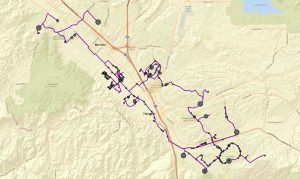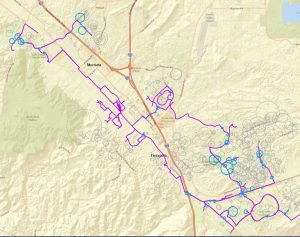In support of the Rancho California Water District’s (RCWD) development of a Recycled Water Resources Plan (Plan), KJ utilized GIS tools to develop cost parameters to provide RCWD with a concise strategy for expanding its non-potable reuse distribution system.
Eighteen project alternatives were analyzed as part of the Plan for excess recycled water, including alternatives for indirect potable reuse, direct potable reuse, stream augmentation, conjunctive use, and non-potable reuse expansion. One of the non-potable reuse alternatives consisted of expanding RCWD’s existing tertiary recycled water distribution system to potable water irrigation or agricultural customers that can be connected in a cost-effective manner.
But because RCWD has an abundance of similarly sized irrigation or agricultural customers within its service area, developing a market assessment and expansion strategy based on cost-effectiveness is very difficult. There is not a handful of large “anchor” customers that can help define pathways for the distribution system expansion.
Working closely with RCWD staff, KJ developed a new method to determine the cost-effective customers who would be served by the expansion of the existing recycled water distribution system. GIS mapping software was connected to a database of potential customers’ water demand. Using established unit costs for pipeline installation, service laterals, meters, and on-site retrofits, a “radius of cost-effectiveness” (RoCE) was calculated for each customer, which represented the length of pipeline that would be built from the customer to the existing distribution while passing the cost-effectiveness criterion. For example, the greater the customer demand, the larger its RoCE would be.
After calculation of each potential customer’s RoCE, the data was uploaded to a GIS database to graphically depict circles of cost-effectiveness for each customer. The customers and their corresponding circles were super-imposed with the existing recycled water distribution system. If a customer’s circle crossed a segment of the existing distribution system, it was considered cost-effective. This graphical crossing represented a customer whose cost to serve was deemed cost-effective by RCWD’s cost criterion. Using this new method, over ninety of the most cost-effective RCWD customers were identified. This innovative method allowed for a mathematical and unbiased approach to expanding a recycled water distribution system in a cost-effective manner. Although this method was specifically developed for the Plan, it can be implemented to complete future complex market assessments, the phasing of recycled water system expansions, and water supply planning for RCWD and other agencies with new or growing non-potable recycled water systems.
The Plan is currently being finalized by KJ and RCWD is planning to move forward with the non-potable reuse expansion project in the near future. We will keep you updated!



